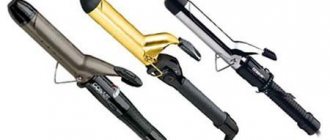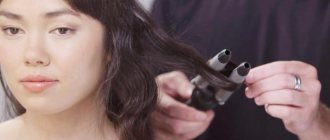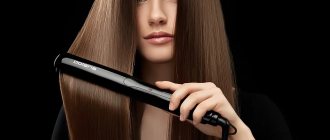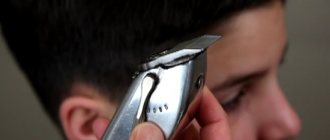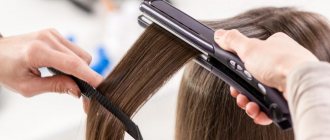Before you disassemble your hair straightener, you need to carefully weigh your options. Despite the apparent simplicity of the device, this operation can lead to the complete unsuitability of the curling iron for further use. To repair a straightener designed for hair styling , you must be able to use a screwdriver and side cutters, have your own soldering iron and tester. Knowledge of radio engineering and plumbing will be useful.
Curling device
The design of the curling iron resembles a clamp. It consists of two parts fastened on one side. Ceramic heating elements are installed on each part, opposite each other.
In addition to the heaters, the design includes: a switch, a power indicator, a power cord and housing parts. The heating elements are electrically connected in parallel and have the same power. Thus, the hair is heated evenly on both sides at the same temperature.
The working surfaces are pressed against the hair by hand, and the reverse action is performed by a special spring. By default, the heating elements are moved to the side using this spring, but there are models of curling irons that have a special latch that keeps the two parts together.
This function simplifies the transportation and storage of this type of device. There are also models with temperature control, LCD display and anti-kink technology.
But as practice shows, the simpler the model, the less it breaks, since additional components only reduce the reliability of the device.
The simplest curling irons can also fail, either partially or completely.
Below in the article we will describe the repair of a mid-level curling iron. But the method for determining malfunctions and repairs may be applicable to other devices of this type. The photo (Figure 1) shows a curling iron with one heating element not working.
Of course, you can get by with it, but it’s unlikely to achieve the most effective styling result. Therefore, it makes sense to try to repair this malfunction, especially since today, curling irons are not so cheap, and damage can be easily repaired.
If the heating element does not work, this does not mean that the nichrome spiral inside it has burned out. Options may vary. A burnt wire is of course the worst thing that can happen. In this case, repairs are impractical and sometimes completely impossible.
Rice. 2. Specifications
This happens extremely rarely, and only through the fault of the consumer, when the element overheats due to the fact that it is not turned off from the network after use.
So, let's start disassembling the device.
Due to the fact that the curling iron is intended mainly for the fair half of humanity, its design should not contain any screws, nuts or other parts that spoil the appearance.
Therefore, sometimes it is very difficult to understand where to start disassembling and where the hidden screws are.
Sometimes such searches end in broken body elements. Without seeing any screws, people begin to pick at the joints, hoping that the parts will be held in place with the help of plastic latches. As a result, a broken device and a bad mood.
In this case, it is better not to rush, but to inspect the device under good lighting for the presence of elements of decorative panels that hide the fastening screws.
Since the main force from the spring is transferred to the junction of the two parts of the curling iron, this means that the main fastening screw should be somewhere there (Figure 3).
Rice. 3. Looking for the fastening screw
If you find a supposed hidden plug, then you don’t need to make much effort to pick it out. Just move the plug a little and it should show whether it can be removed.
After a short search, it was discovered where the main fastening screw was hidden (Figure 4).
Rice. 4. Location of the main fastening screw
It was possible to remove the plug without much difficulty, using a screwdriver to pick out the joint. The plug was removed and underneath was the head of a plastic pin.
Rice. 5. Remove the plug
It is not difficult to assume that the screw is located on the opposite side, under the same insert.
Rice. 6. Remove the plug from the opposite side
We remove it, and here it is - the long-awaited screw.
Rice. 7. Fastening screw
We unscrew this screw with a screwdriver and carefully remove the plastic pin that holds the two working parts of the curling iron together.
When removing the pin, it is advisable to squeeze the upper and lower parts of the device with your fingers, since the spring force will not allow this element to come out freely.
Rice. 8. Remove the plastic pin
When the pin is removed, the two parts of the curling iron will separate, and they must be carefully placed so as not to break the conductors going to the heater.
Rice. 9. The pin is removed
Pull out the spring and put it aside (Figure 10).
Now you can access the screw of the part that secures the input network cable (Fig. 11). Unscrew this screw and remove the part.
Rice. 10. Pull out the spring
Rice. 11. Screw fixing the input network cable
The cord now moves freely. Two wires come out of the cord - blue and brown, which go further under another decorative panel (Fig. 12).
Rice. 12. Two wires
It is also held on by screws, and there are two of them.
Rice. 13. Remove the decorative panel of the curling iron
Remove these screws using a screwdriver and carefully remove the panel.
Below it is a board with a small number of electronic components (Figure 14 and 15).
Rice. 14. We get access to the curling iron board
Rice. 15. Full view of the electronic board
There is: a switch, an indicator LED and an LED quenching resistance.
We examine the board from both sides. This must be done carefully, without once again bending the conductors going to the heaters. If they are strongly bent, they can easily break, which will lead to even greater problems, since their length may simply not be enough, and nichrome is very poorly soldered.
Rice. 16. Electronic board on the reverse side
Judging by the diagram, both wires from the power cord come to the board, and at one of its ends - brown - both leads from each heater are soldered.
Through the second wire - blue - the mains voltage goes to the switch, and from it to the LED and both second terminals of the heater.
If we take into account that one heating element is working, then the switch and power cord are working, and there is no particular need to “ring” them.
Carefully examining the junction of the non-working heater leads on the board, it was discovered that one of them had torn out a piece of the board track along with the soldering, thereby breaking the power circuit.
Rice. 17.
Most likely, this happened due to the special rigidity of the nichrome wire, and of course the heating. To solder a torn piece of a board track with the output of a heating element, you need to clean off the paint on the adjacent track.
This can be done with a knife or a file until the shine of freshly stripped copper appears.
Rice. 18. Cleaning up the paint on the walkway
Next, you need to tin this area, otherwise the soldering will not be strong, and the break may happen again. This can be done using rosin or its alcohol solution. We apply flux to the cleaned area and use a soldering iron with a small amount of tin to tin this area (Figure 19 and 20).
Rice. 19.
Rice. 20. Use a soldering iron for tinning
When the copper can be tinned, we solder to it the separated track with the lead from the heater.
Rice. 21. Result of soldering
Having made sure that the soldering is reliable, we install the board in its place, having previously laid out the leads of the nearby element.
Rice. 22. Install the board in place
Before assembling the curling iron, we check its functionality. We switch the switch on the board to the “ON” mode and plug in the cord into the 220 V network. The LED lights up, which means that the network voltage has gone to the terminals of the heating elements. During operation, do not touch the board with your hands, as you may receive an electric shock. This can only be done when the tension is relieved.
After a few seconds, we try with our finger to see if both elements are heating. In this case, soldering gave its results. Both heaters are heating up. We can assume that the cause of the breakdown has been found and the defect has been eliminated.
Now you need to unplug the cord and wait until the device cools down so as not to burn your hand when assembling it. We lay the remaining wires so that they do not interfere during assembly, avoiding strong kinks and tension. Also keep an eye on the mounting locations for the screws. The wires should move smoothly around them.
We put an additional adapter on the switch lever. We install the first decorative strip (Fig. 23).
Rice. 23. Install the first decorative strip
The LED and switch lever should fit into the corresponding holes in the plate. You should tighten the screws only when you are convinced that the panel has completely sat down and there are gaps and protruding wires between its edges.
Next, we lay out the cord outlet and place a clamping piece on it. We tighten it with a screw (Fig. 24).
Rice. 24. Tighten the screw
We insert the spring into the corresponding socket and join the two parts of the curling iron.
Rice. 25. Insert the spring
Overcoming the force of the spring with the help of your fingers, we insert a plastic pin, connecting the elements of the curling iron to each other (Figures 26 and 27).
Rice. 26. Connecting the curling iron elements together
Rice. 27.
After the pin is in place, tighten the fixing screw.
Rice. 28. Tighten the fixing screw
We put on the decorative plugs on both sides, pressing them with our fingers.
We check how the spring works by squeezing the curling iron.
Rice. 29. Checking how the spring works
We turn on the device and once again check the heating of both ceramic elements.
As it turned out, the problem was minor and was resolved without much difficulty.
Rice. 30. Hair curler in working order
Now the device will last for several more years, making its owner beautiful and attractive.
DIY repair
Repairing a hair curler does not take much time. To repair the styler, you will need two screwdrivers (Phillips and flat head for removing plugs), a piece of electrical wire, a multimeter, and insulating or adhesive tape.
When the moving contact oxidizes, the parts must be separated. Then carefully sand both elements with very fine sandpaper.
Just in case, check the cord with a multimeter. This way you will know if there are any breaks or pinches. If such damage is found, be sure to replace the wire.
When the curling iron begins to press the hair worse, it is necessary to straighten the spring. To do this, you need to remove the retractable stand and carefully unscrew the fasteners.
Sometimes it is enough to pry the spring with a flat screwdriver or your finger - and it easily falls into place. But it also happens that you have to remove it from the body and return it to the desired position separately from the device.
After carrying out these manipulations, put the clamp in place, secure it tightly with bolts and install the lower retractable bracket-stand.
As you can see, the design of this electrical appliance is so simple that repairing it at home is not at all difficult. However, before you start repairing, you need to learn how to properly disassemble the curling iron.
Disassembly
To understand what exactly caused the curling iron to fail, you need to disassemble the device. Models from different brands are designed approximately the same. Having learned how to repair one styler, you will successfully cope with the repair of any other device for styling curls.
All tongs consist of two halves. They need to be sorted in this order:
- Carefully pry off the plugs on both sides with a flat-head screwdriver.
- Unscrew the bolt that holds the two halves of the curling iron together.
- Examine the condition of the wiring for kinks, spring clamping force and contacts.
After establishing the exact cause of the malfunction, you can proceed directly to repairing the device. Don't forget to grab the tools mentioned above right away.
Fault options
There are many reasons for a curling iron to break. However, there are a few that are most common. Let's look at the most common types of faults.
It is recommended to watch a video on how to troubleshoot a curling iron. A visual example will help you navigate faster.
| What's happened | Cause | Troubleshooting method |
| There is no power to the temperature controller board. | Wire fault. | Disassemble and carefully inspect the curling iron. Check the soldering of the cord to the board. If it is torn off, you need to cut off the damaged part and solder the wire in place. A broken connector is quite difficult to repair. It is recommended to exclude it from the circuit by soldering the cord directly. |
| Of the two halves of the tongs, only one works. | Soldering errors or broken heating element. | Disassemble the heating element. These are 2 plates with a resistor between them. Be especially careful with the conductive layer. We must not allow it to be erased. The malfunction is eliminated by ensuring contact of the wire with the heater plate. |
| The device does not heat up when full power is supplied to the board. | Poor soldering or burnt part. | Inspect the board. If nothing suspicious is observed, “ring” all the elements in turn. Start with the fuse. Most often, diodes and a quenching resistor are responsible for blowout. Don't forget to pay attention to the capacitor and variable resistor (if you see the latter in the diagram). |
Have you completed all the manipulations, but the device still does not work? Then it’s better to contact a specialist. Repairs may require special skills or tools.
Repairing the swivel
The purpose of the swivel is to rotate the styler. If used improperly, the wire may become severely twisted. As a result, a break occurs at the point where it is attached to the body.
You can repair the cord by insulating the exposed part. However, such repairs will be short-term. Often he threatens with electric shock in the future.
To properly repair a swivel, you need to do the following:
- Disassemble the tongs.
- Strip the ends of the exposed wires with a knife.
- Prepare your guides.
- Solder the central core and wrap it with several layers of electrical tape. Then do the same with the second one.
- Tie the ends together and secure them with copper wire.
- After some time, remove the wire.
- Assemble the device.
If you did everything correctly, the styler will function as before. If suddenly it doesn’t work out, it’s okay. Take the curling iron to a workshop and let an experienced specialist handle it.
Replacing the heating element
If your styler suddenly stops working, immediately check to see if the wire is damaged. The curling iron turns on normally (the indicator light comes on), but does not heat? Apparently, the heating element is to blame, which most likely burned out.
How the device works
Modern curling irons on the market are distinguished by a variety of shapes and a range of functions. But, regardless of the brand or model, they are all similar in design.
The basis of the device is a round body with a heating element inside and a triangular flexible leg-stand. A power cord with a plug is connected to the handle. A metal clamp is hinged.
Unfortunately, the simple design of the styler does not guarantee its reliability and trouble-free operation. Even the cheapest models of the most popular brands fail.
If you repair your hair curling iron yourself, you can save money and time that you would spend on visiting a specialist. The main thing is to correctly disassemble the device and determine the cause of the malfunction.
Possible breakdowns and solutions
- There is no power on the temperature controller board - the cord is faulty. It needs to be inspected and the soldering to the board checked. If a break is detected, the damaged part is cut off and the cable is soldered in place. A faulty connector is difficult to repair, so you can simply exclude it from the circuit and solder the cord directly.
- Only one half of the tongs works - the tenge is broken or the soldering is bad. Eliminated by disassembling the heating element. It represents two plates with a resistor between them. When disassembling, special attention must be paid to the conductive layer so that it is not accidentally erased. Troubleshooting comes down to ensuring contact between the wire and the tena plate.
- Power is supplied to the board, but the hair iron does not heat up - poor-quality soldering, burnout of one of the parts. The board is being inspected. If there are no visible defects, all elements are called sequentially, starting with the fuse. The most common failures are the quenching resistor and diodes. Particular attention should be paid to the capacitor and variable resistor (if provided schematically).
As you can see, it is quite possible to repair a hair straightener yourself. However, we should not forget about electrical safety rules and restore the device only when disconnected from the network.
Hair curler malfunction
The problem appeared after the device fell from the cabinet onto the floor. It manifested itself in the fact that the hair straightening attachment did not press the strands, thus the desired effect was not achieved.
When you pressed the lever with your finger, the upper part of the electric forceps was lifted, but did not return to its original state. It was clear that something was wrong with the return spring.
But getting to the spring turned out to be not so easy. To do this, it was necessary to disassemble the entire structure. Here's how to do it. Remove the nozzle from the handle by turning the clamping ring.
Let's sum it up
To prevent suddenly broken curling irons from ruining your hairstyle and mood, you need to take the choice of this device very seriously. But since purchasing even the most expensive styler does not guarantee its eternal operation, it is better to immediately acquire the tools necessary for repairs.
Do not try to disassemble the iron after purchase. Firstly, it will still be under warranty. And secondly, there is a risk that you will not put it back together. And instead of a brand new device, you will receive a non-functional set of parts. It’s another matter if the styler is already broken - in this case, you definitely have nothing to lose.
If you cannot repair the tongs yourself, do not hesitate to seek help from a specialist. After all, the main thing is a functioning device, and not who repaired it.
It's no secret that every woman wants to be unique and attractive. There are many different ways to do this, for example, cosmetics, various skin treatments, manipulation of eyelashes and nails. Nothing makes a woman more special than her hair. And for this there are many devices and devices. One of these beauty tools is an electric curling iron.
It is mainly intended for straightening hair and also helps to cope with unruly curls when forming bangs.
Rice. 1. Repairable hair curler
The working principle of a curling iron.
Slightly damp hair is clamped between two heating elements. When moving the elements along the entire length, the hair dries and becomes even. Thus, unruly “curls” can be turned into a perfectly even, straight hairstyle.
You can use a curling iron not only with wet hair; dry hair can also be straightened, but not as effectively as the former.
P O P U L A R N O E:
- DIY incubator.
What to do if the hen does not arrive in time? And the number of young animals produced is not always satisfactory, and serial incubators are a bit expensive.
There is only one way out: try to mount it yourself.
The chamber for a simplified model of an incubator can be ordinary cardboard boxes, pasted inside and outside with layers of thick paper, wooden frames, sheathed on both sides with plywood or plastic, filled inside and between the walls with glass wool, dry sawdust, and foam. Read more…
OSCILLOGRAPHIC ATTACHMENT FOR TV
Descriptions of oscillographic TV attachments have already been published on the pages of the magazine (Radio, 1959, No. 1; 1965, No. 8, etc.). However, unlike them, the proposed set-top box does not require intervention in the TV circuit (it is connected to the TV antenna socket). Together with a sweep frequency generator, it can be used to set up IF amplifiers for radio receivers. Read more…
Device for checking the voltage limits of radio components
When repairing, setting up, or creating new circuit diagrams, you may need a device to check the values of permissible voltages and leakage voltages of transistors, diodes, capacitors and other radio components.
The article below presents a diagram of such a device based on a converter based on MS 1211EU1.
Read more…
Popularity: 5,965 views.
How to disassemble a DEWAL curling iron
Simple models of hair clippers are practically no different from the usual razors from the times of the USSR. The only difference is that in modern models of hair clippers the vibrator is pendulum, so the blade moves not horizontally, but in an arc. Before you repair your hair clipper, you need to understand the internal structure of the device. At first glance, the design of the machine is simple, without technological bells and whistles, so no difficulties are expected in the repair process.
Advantages and disadvantages
The advantages of Bosch rectifiers have already been appreciated by many customers:
- Stylish and compact design . The brand's irons are pleasant to hold, they are easy to use and take their rightful place on the dressing table. In addition, any of the straighteners can be taken with you on trips; it will not take up much space in your bag and will add almost no weight to it.
- Possibility of temperature adjustment. You determine the level of heat required for your hair. For those with colored, thin or damaged strands, temperatures above 150° C are not recommended. Normal hair types can withstand temperatures up to 180° C. If you have coarse hair, you may need maximum heating to achieve the ideal effect. The required temperature also depends on how naturally curly the hair is.
- Ionization . A special layer covering the plates of the device releases negative ions when the temperature increases. They, in turn, restore the water balance of each hair, creating the visual effect of silky and well-groomed curls.
- Durability . Anodized plates are resistant to damage and retain their original appearance and properties for a long time.
- Variety of models. Among the brand's assortment you can find a small iron with a minimal set of functions and a universal device for smoothing and curling hair. With this device you can change your looks and always look amazing.
Some buyers can name only the expensive cost of the brand’s products as a negative nuance.
How to disassemble rowenta
To learn how to choose the right hair straightening iron, as well as other medical recommendations, see the following video. Repair of heating element, disassembly of Maestro hair straightener curling iron. The iron is more suitable for hair of medium length, since the width of the plates is less than average, but if you are not in a hurry, this device can be used.
Compact and gentle, the tourmaline-coated hair straightener has a pleasing design. The manufacturer has provided a matte finish here, which makes the device stylish, and there are no unnecessary details on the surface. You cannot hold the iron in one place, so as not to damage your hair; if you do this, you will leave a scorched mark. To maintain volume, you can straighten only the top strands.
The design of the board and the element base are considered. This iron not only straightens the hair, but also restores its water balance. Such plates are unique, only this material is enriched with particles of negative charge, natural minerals, which interact with the hair during the procedure.
Mineral properties provide care, this is reflected in the touch and appearance. A product equipped with such plates has no particular complaints, it belongs to the premium class, and its cost will be above average. The only thing that is required of you is to be careful, tourmaline surfaces are quickly damaged, try not to scratch them. We are trying to fix the hair straightener. I'm not a pro at repairs, so be lenient. When heated, the tourmaline iron releases negatively charged ions, which make the hair soft and shiny, and most importantly, do not dry out the hair, as they maintain water balance.
My Instagram - In the DIY section - repairing a hair straightener with your own hands Four-channel ionization protects the structure of each hair, retaining moisture in it and creating a visual effect of 3-dimensional shine. The temperature regulator allows you to customize the device taking into account your hair type and individual characteristics.
Hair curler repair. And the temperature adjustment mode allows you to use it for every hair type. Takes care of hair protection, floating plates and the presence of ionization will not disturb the water balance.
As the owner of curly hair, I always try to straighten it with hair dryers, straighteners, and tight ponytails. One day my hairdresser tempted me to try creatine hair straightening.
Disassembling the curling iron, restoring and repairing the power cord. Another plus is that the device heats up in just a minute. This is not a Soviet curling iron, which took a lot of time to accelerate! That's all the instructions for repairing an iron with your own hands. As you can see, the event is quite simple and even a novice electrician can do it! Finally, I would like to note that if the red indicator on the case is blinking, do not panic, because read the instructions that come with the kit to understand the reason for the blinking.
We hope that now you understand what to do if the soleplate of the iron does not heat up and how to repair the breakdown at home! An air mattress with a special built-in pump is very practical. And this is important for apartments or Guys, I have a problem: the spring that opens the gas tank flap has broken, has anyone encountered this? If the plastic is suitable, for example, polystyrene or polymethyl methacrylate, but polyethylene or polypropylene, which, by the way, If the button on the hammer drill is broken, then you can try to repair it .
Just don’t rush to buy. The hair straightener is broken and does not heat up. Repairing a hair straightener. For information on how to choose the right hair straightening iron, as well as other medical recommendations, see the following video.
Repair the built-in pump in the mattress An air mattress with a special built-in pump is very practical. The wisdom tooth broke and the root remained in the gum. It’s already the 3rd day since the root of the tooth on the upper gum was removed.
I do it every hour. The hook in the removable denture is broken, what to do. One of the types of fixation of dentures in the oral cavity is fastening with hooks. The spring on the curling iron is broken, what to replace it with? Guys, I have the same problem: the spring that opens the gas tank flap has broken, has anyone encountered this problem? How to fix a zipper that came off? from fabric If you can't fix the slider, you'll have to buy a new one. The size of the runner should be How to Fix a Wall Mounted Clothes Dryer Want to learn how to fix a clothes dryer at home?
I will share with you, How to repair a basin made of plastic If the plastic is suitable, for example, polystyrene or polymethyl methacrylate, but polyethylene or polypropylene Which, by the way, How to repair a button on a hammer drill If the button on a hammer drill is broken, then you can try to repair it.
Disassembling the case
First, using a Phillips screwdriver, unscrew all the fastening screws around the perimeter of the styler attachment.
Some screws are deep-set so that not all screwdrivers fit into the diameter of the hole. For such places you need to choose a suitable tool - a thin screwdriver.
We do the same with the two screws securing the contact socket at the end. After this, carefully lift the plastic side of the case.
Now you can see the bottom heater of the styler and the wires going to it.Remove the upper part of the body. This releases the upper heater and provides access to the spring and other parts of the hair curling iron.
Repairing a clothes steamer with your own hands
First, you should read the technical documentation. Then disassemble the housing and ring the electrical parts to find out if there is resistance to electric current. After the repair is completed, the device is briefly connected to the network to check its functionality. Only then do they start assembling.
If the thermostat tablet turns out to be faulty, repairs may take longer. You will need to buy burnt out parts. In this case, only original ones are needed. It is advisable to seek help from specialists, as incorrect actions can cause a short circuit.
Who can repair their hair curling iron themselves?
First, it should be noted that fixing a curling iron is quite a serious matter, requiring skills in repairing electrical appliances. If you basically understand electrical repairs, have experience in such repairs and have the necessary tools - an electrical tester and a soldering iron, at a minimum - then you can cope with this. You won't find anything super complicated or super specific here.
But if you do not have the necessary skills and do not have the necessary equipment, it is better not to get into the inside of the iron, because you may not only not achieve results, but also create new things, further complicating future repairs for those who will do it.
Hair straightener Rowenta
From time to time I do minor repairs to home electronics and household appliances. One day I was approached with the following problem: due to a weak clamp, the client was unable to manipulate her hair. Curling irons, as you know, have firmly taken a confident position in the household of almost all representatives of the fair sex, and those who do not have a curling iron have its modern modification - irons. In the above work, a ceramic curling iron from Maestro was repaired, although the repair principle is the same almost everywhere and can be applied to any other curling iron of a similar design. This repair required only a Phillips screwdriver and strong fingers. The total time to repair the curling iron with your own hands, including photographing the process, took no more than half an hour. First of all, remove the retractable stand.
Cause of malfunction
The cause of the problem became immediately clear. It was a plastic L-shaped part of the case, which simply broke off when dropped. Therefore, the spring has lost its stop and ability to return the working surface to the desired position.
It became clear that simply gluing the broken piece back together was not the solution. It was necessary to come up with something more reliable. In any case, for convenience, it is better to remove all the parts of the styler and put them aside.
Rating of the best curling irons
Knowing how to disassemble your curling iron and repair it yourself will extend the life of the device. And this is certainly a positive thing. However, in order to avoid repair work or at least minimize it, you should initially try to choose a high-quality styler.
Today, the beauty device market is replete with a huge number of models that can give curls a wide variety of shapes. Small and large curls, Hollywood curls, corrugations - this is not a complete list of styling.
There are also curling irons on sale that do the gripping and twisting of the strands themselves. Technological progress does not stand still. Manufacturers are doing everything possible to improve the convenience and modernize the functionality of stylers.
When choosing a device, first of all you need to pay attention to the brand. This is the most important criterion. The more serious and well-known the company, the longer the purchased curling iron will last and the better the curl will be.
Among the leaders in the rating are the following brands:
- "Roventa";
- "Remington";
- "Philips";
- "Brown"
- "Bosch"
- "Vitek";
- "Scarlett";
- "Polaris".
Stylers from the listed manufacturers can probably be seen in any home appliance store. They cannot be considered cheap. And yet they are in high demand.
In addition to the brands mentioned above, there are also professional curling irons that are sold only in specialized outlets. If you believe the reviews, the best among them are:
- "Bebilis";
- "Deval";
- Velecta Paramount;
- "Valera."
Of course, the latest devices are more expensive. True, they compensate for the costs with their endurance and long service life.
Design and principle of operation of the device
Any brand of hair straightener falls into the category of heating devices. The ironing plates are shaped like a clamp, due to which the curls are straightened. The operation of the device is based on high temperatures from 100 to 220 degrees, under the influence of which the hair straightens. The plates press the hair using a spring installed inside.
Regardless of the specific model, the general equipment diagram is as follows:
- a main body shaped like tongs, equipped with a cord for connecting to a source of electrical energy;
- heaters installed inside - heating elements;
- a regulator that allows the user to select the optimal temperature regime.
Accordingly, a breakdown is possible in one of the indicated links. The Bosch brand offers a fairly large range of similar equipment; the main differences between the models are the design, characteristics and the presence of additional functions that increase the ease of use of the device. Depending on this, additional points are added to the list of possible breakdown locations where damage occurs and the device fails.
Hair curling iron. A look from the inside.
Study of the operating algorithm of the electronic thermostat of the Remington S-8660 hair curling iron
Household appliances break down, and “women’s” household appliances break down especially often
But why not use what is still suitable in your homemade screw crafts?
I got my hands on modern pliers (multi-styler) Remington S-8660, unfortunately, without “attachments” - only a handle with “stuffing”.
To carry out the work, you need to prepare the following devices and tools:
- Handle assembly or controller board for Remington S-8660 hair dryer
- tester or multimeter
- two-point screwdriver (fork)
- soldering iron
- variable resistor 27-33 kOm
- low-power incandescent lamp 220 volts
- installation wire
An autopsy showed that inside the handle there is a digital thermostat made on the HS153SN chip. Searches on the Internet gave the answer - that this is most likely a Chinese clone of the one-time programmable microcontroller EM78P152/3S.
The hair dryer accessories are connected to the handle via a 4-pin connector - 2 wires are used for the heater, two more for the temperature sensor.
To check the functionality of the thermostat, a test bench was assembled - a variable resistor with a nominal value of 33 kOm, simulating a thermistor, was connected to points T1 and T2; to points H1 and H2, a load in the form of a light bulb from a refrigerator (220 volts, 15 watts); to points AC1 and AC2 – mains voltage.
When you press the “on/off” button, the first green LED begins to blink, and the hair dryer begins to warm up to the minimum temperature - the load lamp lights up continuously.
When you press the “Up” button further, the next green, two yellow and the last, red LEDs light up in sequence. In temperature set mode, all LEDs blink.
As the temperature rises, the LEDs, one after another, sequentially switch to continuous glow mode.
When a certain temperature of the sensor is reached, the load lamp begins to blink, with a period of 4-5 seconds it turns on for 1-2 seconds, which achieves more accurate regulation of heat generation in the load. We will consider these points to be the thermostat setting points.
If the variable resistor—the “sensor”—is adjusted to a lower resistance, the lamp goes out, and if it is adjusted to a higher resistance, it lights up continuously. The results of measuring the sensor resistance, with rounding, are summarized in the table:
The last two lines may have an increased error, since a variable resistor may “produce” a not very stable resistance in this range; for more accurate measurements it is better to use a resistance magazine, or, in extreme cases, use a “variable” with a resistance of 3.6-5, 1 kOhm.
And yet, using the results obtained, you can use a digital thermostat to build, for example, a soldering station, a temperature controller for an aquarium, a boiler, an air heater, etc. The temperature sensor may consist of a thermistor and several resistors connected in parallel and in series with it to obtain the required control characteristic. The sensor must have good thermal contact with the controlled object.
It is impossible to change the microcontroller program, so the desired exact temperature can be obtained only in one mode, to choose from, and in the rest you can be content with what can be obtained by adjusting the characteristics of the temperature sensor.
Therefore, the use of such a thermostat can only be justified by the fact that it was obtained for free and by the fact that it is a ready-made, already assembled device.
To control a powerful load, it is necessary to use an additional thyristor cascade, the diagram of which can be obtained from the Internet.
Since the circuit has a galvanic connection with the electrical network, the sensor must be reliably isolated, and electrical safety must be observed during setup work and further operation !
Author – Manuilov V.P.
P O P U L A R N O E:
Turning on the computer
There are a lot of solutions for controlling a computer from a remote control, for example, IR receivers from Microsoft, GotView, etc. Existing auxiliary software allows you to flexibly configure the control of application programs from the remote control, such as video or audio players, almost turning the computer into a multimedia center. Unfortunately, only “almost”. For the most part, IR receivers are deprived of one very important function - they do not allow you to turn on the computer remotely - from the remote control. Read more…
Which TV is better?
Televisions, like all household appliances, are constantly being improved; technical innovations appear that you can’t keep up with. If you bought your TV five years ago, then you can already say that you are behind the times. After all, modern TV really has fundamentally different qualities in many respects.
In the article below, let's discuss what requirements a modern TV must meet.

